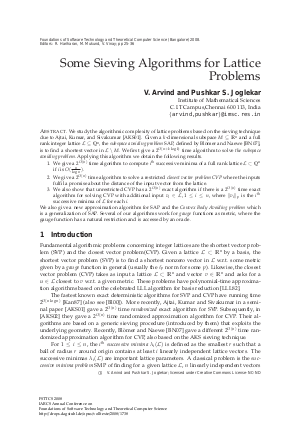Some Sieving Algorithms for Lattice Problems
Authors V. Arvind, Pushkar S. Joglekar
-
Part of:
Volume:
IARCS Annual Conference on Foundations of Software Technology and Theoretical Computer Science (FSTTCS 2008)
Part of: Series: Leibniz International Proceedings in Informatics (LIPIcs)
Part of: Conference: IARCS Annual Conference on Foundations of Software Technology and Theoretical Computer Science (FSTTCS) - License:
 Creative Commons Attribution-NonCommercial-NoDerivs 3.0 Unported license
Creative Commons Attribution-NonCommercial-NoDerivs 3.0 Unported license
- Publication Date: 2008-12-05
File

PDF
LIPIcs.FSTTCS.2008.1738.pdf
- Filesize: 435 kB
- 12 pages
Document Identifiers
Subject Classification
Keywords
- Lattice problems
- sieving algorithm
- closest vector problem
Metrics
- Access Statistics
-
Total Accesses (updated on a weekly basis)
0PDF Downloads0Metadata Views
Abstract
We study the algorithmic complexity of lattice problems based on the
sieving technique due to Ajtai, Kumar, and Sivakumar~\cite{aks}.
Given a $k$-dimensional subspace $M\subseteq \R^n$ and a full rank
integer lattice $\L\subseteq \Q^n$, the \emph{subspace avoiding
problem} SAP, defined by Bl\"omer and Naewe \cite{blomer}, is to
find a shortest vector in $\L\setminus M$. We first give a $2^{O(n+k
\log k)}$ time algorithm to solve \emph{the subspace avoiding
problem}. Applying this algorithm we obtain the following
results.
\begin{enumerate}
\item We give a $2^{O(n)}$ time algorithm to compute $i^{th}$
successive minima of a full rank lattice $\L\subset \Q^n$ if $i$ is
$O(\frac{n}{\log n})$.
\item We give a $2^{O(n)}$ time algorithm to solve a restricted
\emph{closest vector problem CVP} where the inputs fulfil a promise
about the distance of the input vector from the lattice.
\item We also show that unrestricted CVP has a $2^{O(n)}$ exact
algorithm if there is a $2^{O(n)}$ time exact algorithm for solving
CVP with additional input $v_i\in \L, 1\leq i\leq n$, where
$\|v_i\|_p$ is the $i^{th}$ successive minima of $\L$ for each $i$.
\end{enumerate}
We also give a new approximation algorithm for SAP and the
\emph{Convex Body Avoiding problem} which is a generalization of SAP.
Several of our algorithms work for \emph{gauge} functions as metric,
where the gauge function has a natural restriction and is accessed by
an oracle.
Cite As Get BibTex
V. Arvind and Pushkar S. Joglekar. Some Sieving Algorithms for Lattice Problems. In IARCS Annual Conference on Foundations of Software Technology and Theoretical Computer Science. Leibniz International Proceedings in Informatics (LIPIcs), Volume 2, pp. 25-36, Schloss Dagstuhl – Leibniz-Zentrum für Informatik (2008)
https://doi.org/10.4230/LIPIcs.FSTTCS.2008.1738
BibTex
@InProceedings{arvind_et_al:LIPIcs.FSTTCS.2008.1738,
author = {Arvind, V. and Joglekar, Pushkar S.},
title = {{Some Sieving Algorithms for Lattice Problems}},
booktitle = {IARCS Annual Conference on Foundations of Software Technology and Theoretical Computer Science},
pages = {25--36},
series = {Leibniz International Proceedings in Informatics (LIPIcs)},
ISBN = {978-3-939897-08-8},
ISSN = {1868-8969},
year = {2008},
volume = {2},
editor = {Hariharan, Ramesh and Mukund, Madhavan and Vinay, V},
publisher = {Schloss Dagstuhl -- Leibniz-Zentrum f{\"u}r Informatik},
address = {Dagstuhl, Germany},
URL = {https://drops.dagstuhl.de/entities/document/10.4230/LIPIcs.FSTTCS.2008.1738},
URN = {urn:nbn:de:0030-drops-17380},
doi = {10.4230/LIPIcs.FSTTCS.2008.1738},
annote = {Keywords: Lattice problems, sieving algorithm, closest vector problem}
}
